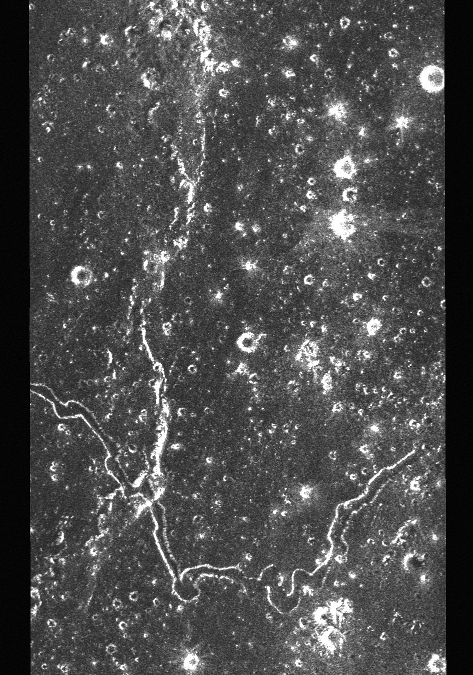Emily Lakdawalla • Feb 22, 2010
Pretty picture: Mini-RF exposes lunar geology
There are all kinds of neat things to see in this recently released image from the Mini-RF synthetic aperture radar instrument aboard Lunar Reconnaissance Orbiter:

Mini-RF is a low-mass synthetic aperture radar instrument aboard Lunar Reconnaissance Orbiter, sister to the Mini-SAR instrument that flew on Chandrayaan-1. This skinny Mini-RF image swath runs from about 7 to 25.5 north latitude, roughly along 49° west longitude, across Oceanus Procellarum. It covers an area about 12 kilometers wide and more than 500 kilometers long (it has been divided into three parts to display better on the web site).
At top is the Cobra Head (24.7° N, 49.3° W; about 7 km diameter), the source vent of the long, sinuous Schroter's Valley, a giant lava channel on the Aristarchus Plateau. The strip continues southward through the lava-filled crater Herodtous, into the maria of Oceanus Procellarum. The otherwise fairly flat mare is peppered with bright dots, secondary impact craters that formed from the debris that flew out of the Aristarchus impact event. The strip covers at least three of the sinuous lava channels of the Marius Hills volcanic complex, including Rima Marius itself near the top of the rightmost (southernmost) strip segment.
The "click to enlarge" version of the image shown here is only 1/3 of its native resolution; the full-length strip is available here (JPG, 11 MB).
Image: NASA / APL / LPIAt top is the Cobra Head (24.7° N, 49.3° W; about 7 km diameter), the source vent of the long, sinuous Schroter's Valley, a giant lava channel on the Aristarchus Plateau. The strip continues southward through the lava-filled crater Herodtous, into the maria of Oceanus Procellarum. The otherwise fairly flat mare is peppered with bright dots, secondary impact craters that formed from the debris that flew out of the Aristarchus impact event. The strip covers at least three of the sinuous lava channels of the Marius Hills volcanic complex, including Rima Marius itself near the top of the rightmost (southernmost) strip segment.
The "click to enlarge" version of the image shown here is only 1/3 of its native resolution; the full-length strip is available here (JPG, 11 MB).
Radar provides a totally different way of looking at a surface than traditional photography. We have radar images of Earth, but for the rest of the solar system, we have usually only sent a synthetic aperture radar (SAR) instrument when we simply can't get optical images. There have been SAR radar mappers sent to both Venus and Titan, where they are able to penetrate the optically opaque clouds to see the surface. The Mini-RF instrument on Lunar Reconnaissance Orbiter and its predecessor Mini-SAR on Chandrayaan-1 are producing the first SAR data on a body beyond Earth for which we also have very good optical data. So I am really looking forward to the global data set that the Mini-RF team will eventually produce on the Moon. It'll take a long time for them to develop their global map; in the meantime, we are treated to occasional tastes of the data in the very long, skinny strips that a synthetic aperture radar instrument produces.
Here are just two interesting things I spotted while poring over the long strip in detail:


Go ahead and explore the big image! What can you find? I highly recommend using Google Earth to get yourself oriented -- just locate the crater Heterodotus to get yourself started.
Let’s Go Beyond The Horizon
Every success in space exploration is the result of the community of space enthusiasts, like you, who believe it is important. You can help usher in the next great era of space exploration with your gift today.
Donate Today

 Explore Worlds
Explore Worlds Find Life
Find Life Defend Earth
Defend Earth

